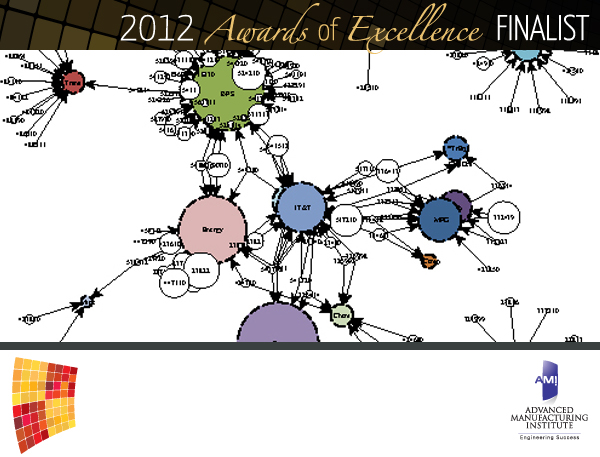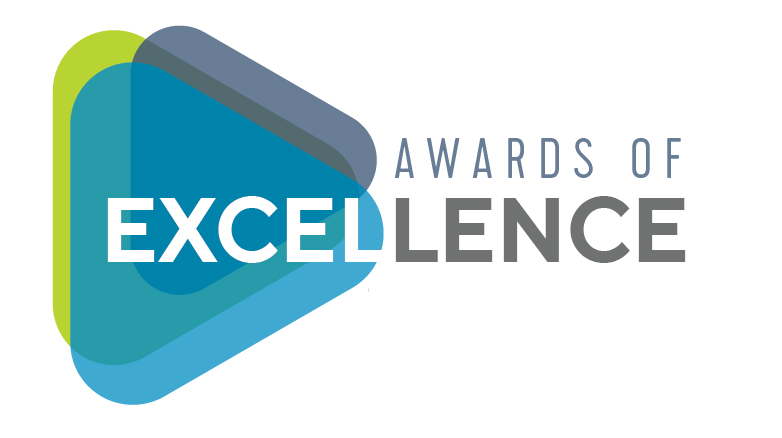Network

| Award Category: | Leadership and Collaboration |
| Project Site: | Kansas Opportunity Innovation Network |
| Submitted By: | Kansas State University |
| Contact: | Brad Kramer, 785.532.5606 |
Case Study
Problem/Background
Experts and policy officials both agree that many regions lack connections to the sources of innovation. Rural and distressed regions in particular are often isolated from ideas and global markets, or are unable to readily connect the two even if they both exist. These regions need intermediaries (individuals, organizations, networks or spaces) to proactively connect people, ideas and resources and then weave these entities into competitive advantage.
Isolated from Marketplaces – Sparsely populated regions are marked by limited idea and opportunity exchange, leading to fewer innovations and less productivity that is aggravated by a lack of geographic proximity to markets, support organizations and other businesses. Inter-woven virtual regional networks can help overcome this isolation and provide the advantages of urban clusters (volume, density and diversity of interactions; proximity to markets) to rural and distressed regions where traditional economic clusters do not exist.
Isolated from Ideas – Globally competitive entrepreneurs rely on their social network of weak ties to access information and learn about new opportunities. Entrepreneurs with extensive weak ties in their network identify significantly more opportunities than an entrepreneur with a smaller network. Unfortunately, many rural entrepreneurs have a limited number of weak ties that leads to structural holes in their exposure to market needs and opportunities. Proactive network weaving, a deliberate process of bridging and connecting to extend one’s social network of weak ties, can close these structural holes. Network weaving creates new and richer connections between and among people, groups, and entities in networks and help participants to constantly learn about the assets and opportunities in and outside the network.
Inability to Connect Globally – Due to their geographic isolation, businesses in distressed or rural Kansas regions are especially apt to lack global networks to overcome their isolation from new ideas and markets in order to sustain meaningful growth in global markets. Fortunately, geographically focused traditional cluster-based development strategies become less relevant in a flat world where entities become specialized network nodes operating in a global economy instead of a hub with everything in one location. To overcome this geographic isolation from innovation opportunities and emerging markets, an agent is needed who will proactively build connectedness.
Needed: Innovation Intermediaries – Innovation intermediaries promote business to business (B2B) collaboration and strategically weave together a region’s assets, resources, and technologies to close structural holes and provide competitive advantage. They work as a connectivity bridge for the region facilitating the flow of ideas, know-how, and intellectual property while leveraging resources, suppliers, customers, university research, government and private organizations. Innovation intermediaries are a critical component to regional innovation systems.
Opportunity – Business differentiation and growth occur when opportunity intersects with ideas and the capacity to respond with innovative products and services. Some Kansas businesses connect with opportunities from around the world while others fail to make the connections necessary to sustain meaningful growth in global markets. Businesses in distressed or rural Kansas are especially apt to lack the informal networks necessary to keep up to date on new and disruptive ideas or opportunities. The challenge for many Kansas companies and the communities and regions they support is creating an environment that transcends geographic isolation, discovers new markets, innovates openly and fosters global competitiveness to increase the probability of being at the intersection of great ideas and new opportunities.
KOIN helps businesses and communities build networks to connect to opportunities that significantly multiplies the capability of Kansas businesses to innovate and grow in rural and isolated areas.
Solution
Kansas State University established the Kansas Opportunity Innovation Network (KOIN) with support from the EDA University Center grant program. KOIN is an opportunity catalyst, boundary spanner, and innovation intermediary for Kansas companies in rural/distressed communities and regions that will help them to compete in global markets with innovative technology-based goods and services.
KOIN is being developed and managed by the Advanced Manufacturing Institute (AMI) at Kansas State University. It provides innovation services to businesses and economic development agents throughout Kansas. Specifically, KOIN conducts the following activities:
- profile the innovation competencies, assets, capabilities, and needs of businesses, communities, and regions in order to identify and exploit business growth opportunities;
- scout new collaborative innovation opportunities outside existing markets and partnerships;
- create an actively-woven innovation network of technology providers, market access, expertise, capital, and potential business partners that will transform opportunities into reality;
- enable companies and regions to readily connect and collaborate in innovative ways in response to opportunities that create a “hard-to-replicate” regional competitive advantage;
KOIN is a statewide public-private partnership. It began with strong regional support leveraging matching investments from two statewide economic development organizations, three EDA Economic Development Districts, one regional development association, one military base Local Development Authority and Kansas State University. KOIN enhances the global competitiveness of rural/distressed companies and regions resulting in business growth that in turn creates higher skill, higher wage jobs in Kansas and generates wealth.
Results
AMI has worked interactively with regional economic development organizations throughout Kansas to develop new analysis and collaboration tools and methods to help spur economic development in rural regions. These tools include: regional asset mapping, business profiling, and social innovation network analysis.
We are applying developed techniques to help regional leaders redevelop an army ammunition plant site that was decommissioned in the BRAC process.
The KOIN team performed a wind energy supply chain analysis for the state. It is also supporting the development of the Kansas Logistics Park and helping to define and establish a manufacturing incubator.
The National Association of Development Organizations (NADO) produced a report about our efforts to build KOIN. We also presented a Know Your Regionwebinar for NADO.
We were invited to share our work with a group of European Union representatives who gathered to discuss good practices in innovation policy at the Encouraging the Commercialization of Research Results and the Utilization of Cluster MappingThrough EU-US Collaborations Workshop in Washington, DC. The workshop supported efforts to build the Transatlantic Innovation Action Partnership and was organized under the Framework of the “Support for International Cooperation on Innovation Policy” project.
Kansas government leaders have charged AMI to use KOIN tools to spur economic development in Southeast Kansas. The KOIN team was able to leverage this challenge by competing for and winning one of the EDA/USDA Rural Jobs and Innovation Accelerator grants.
Future Considerations
tion tools by prototyping the tool to solve a real need, implementing the tool, learning from clients and users, improving the tool and then starting the development process over again.
The EDA/USDA rural jobs and innovation accelerator grant we just won will really test our ability to drive our concepts down into making real technology-based businesses more competitive.
The KOIN team is currently accessing models for sustaining these activities in the long-term.
Finalist Presentation
UEDA Awards of Excellence Finalists presented at the Annual Summit in Chattanooga on October 22, 2012. Summit attendees then voted for the best initiative in each category.

